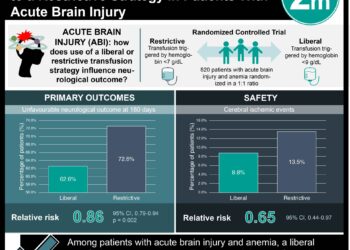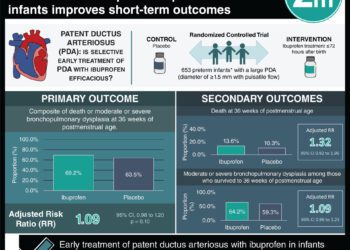Lower target oxygen saturation in extremely preterm infants appears safe
Image: PD/CDC
1. Extremely preterm infants assigned to a lower target oxygenation range of 85% to 89%, compared to 91% to 95%, showed no increased death or disability at 18 months.
2. Extremely premature infants in the lower target oxygenation cohort also did not have increased retinopathy of prematurity or brain injury.
Evidence Rating Level: 1 (Excellent)
Study Rundown: This multinational, randomized clinical trial concluded that there was no significant difference in death or disability in extremely premature infants assigned to target oxygen saturation groups of either 85%-89% or 91%-95%. Also, there was no significant difference in secondary outcomes that included retinopathy of prematurity or brain injury. Unlike this current study, the SUPPORT (US Surfactant Positive Airway Pressure and Pulse Oximetry Trial) trial observed an increase in morbidity and mortality in the lower oxygen saturation target group and a greatly reduced incidence of retinopathy of prematurity. However, in this recent trial, a smaller number of infants were exposed to median oxygen concentrations below 85% or above 95% when compared to the SUPPORT trial implying greater variability. This may explain the observed differences in morbidity, mortality, and retinopathy of prematurity in the SUPPORT trial. Future research should investigate this further to better clarify the different findings in this trial in comparison to the SUPPORT trial. Nonetheless, given the difficulty in maintaining a narrow oxygenation rate in extremely premature infants, it would be reasonable to target oxygen saturation ranges between 85% and 95%.
Click to read the study in JAMA
Click to read an accompanying editorial in JAMA
Relevant Reading: Neurodevelopmental outcomes in the early CPAP and pulse oximetry trial
In-Depth [multi-national, randomized, double-blind trial]: This study included 25 hospitals in 6 countries, enrolling 1,201 extremely premature infants with gestational ages ranging between 23 weeks 0 days to 27 weeks and 6 days. The infants were randomized into two target oxygen saturation groups, 85%-89% (n= 578) and 91%-95% (n= 569). Of the infants assigned to the lower target oxygen range, 298 (51.6%) suffered a disability or died at 18 months compared to 569 (49.7%) of infants in the high oxygen target range (OR 1.08, p =0.52). The rate of death was 16.6% in the lower target oxygenation group compared to 15.3% in the higher oxygenation group (OR 1.11; p= 0.54). Infants in the lower oxygenation group had reduced postmenstrual age at last use of oxygen at 36.2 weeks compared to 34.5 weeks (p=0.03). There was also no significant difference in the secondary outcomes retinopathy of prematurity or brain injury.
By Brittany Hasty and Rif Rahman
More from this author: Transvaginal ultrasound is the best diagnostic method for ectopic pregnancy, Metagenomics: A new method of identifying bacterial outbreaks, Sublingual immunotherapy may be safe and effective for asthma and allergic rhinoconjunctivitis
© 2013 2minutemedicine.com. All rights reserved. No works may be reproduced without written consent from 2minutemedicine.com. Disclaimer: We present factual information directly from peer reviewed medical journals. No post should be construed as medical advice and is not intended as such by the authors or by 2minutemedicine.com. PLEASE SEE A HEALTHCARE PROVIDER IN YOUR AREA IF YOU SEEK MEDICAL ADVICE OF ANY SORT. Content is produced in accordance with fair use copyrights solely and strictly for the purpose of teaching, news and criticism. No benefit, monetary or otherwise, is realized by any participants or the owner of this domain.






![Pointed techniques: an experience of acupuncture and western medicine [Perspective]](https://www.2minutemedicine.com/wp-content/uploads/2013/05/Hua_t08-75x75.jpg)
